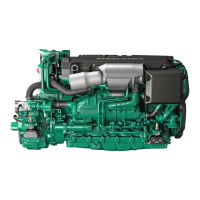
Do you have a question about the Volvo D5 series and is the answer not in the manual?
| Engine Type | Inline 5-cylinder |
|---|---|
| Fuel Type | Diesel |
| Fuel System | Common Rail Direct Injection |
| Intercooler | Yes |
| Displacement | 2.4L (2400 cc) |
| Turbocharger | Yes |
| Torque | 340-420 Nm (depending on variant) |
| Valvetrain | DOHC |
Explains the process of type approval for engines to be classified.
Details the steps for obtaining a classification certificate for an engine installation.
Explains the causes and effects of torsional vibrations in shafts.
Guides on selecting an engine based on performance and installation requirements.
Critical guidance on choosing the correct propeller for optimal engine RPM and performance.
Emphasizes designing the engine room for easy access to components for maintenance and repair.
Details principles for designing and building engine beds and foundations for stability and noise reduction.
Detailed procedures for installing engines using flexible rubber mounts.
Crucial steps for accurately aligning the engine and reverse gear with the propeller shaft.
Covers tank location, height, piping, and ventilation requirements for safe fuel storage.
Details how to measure fuel feed pressure and identify potential system issues.
Critical information on mixing coolant and water for optimal engine protection and performance.
Step-by-step instructions for safely filling the cooling system with the correct coolant mixture.
Discusses principles and arrangements for external cooling systems like keel and central cooling.
Explains thermostat types, opening temperatures, and procedures for external cooling systems.
Illustrates the function and correct connection of expansion tanks for pressure regulation.
Details characteristics, advantages, and installation of wet exhaust systems, including elbow diameters.
Explains design and installation of dry exhaust systems, including insulation and condensation control.
Details the procedure for measuring exhaust backpressure using simple tools.
Details the process of galvanic corrosion and its causes in marine environments.
Recommends bonding components and using sacrificial anodes for corrosion protection.
Explains stray current corrosion and its prevention through proper installation.
Outlines methods for measuring galvanic currents and stray currents using specialized equipment.
Critical checks during test running, including instruments, leaks, and performance.